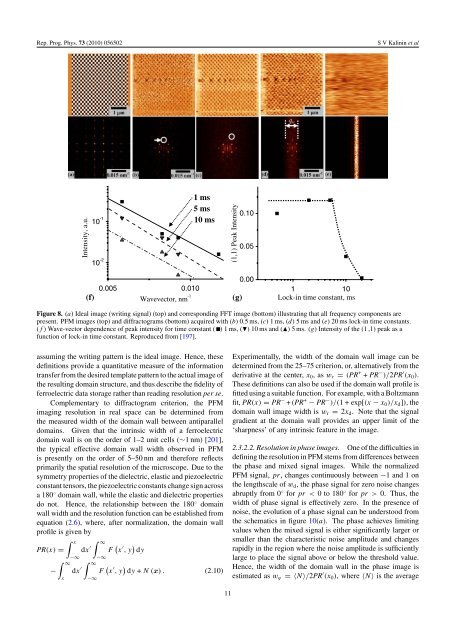Local polarization dynamics in ferroelectric materials
Local polarization dynamics in ferroelectric materials
Local polarization dynamics in ferroelectric materials
You also want an ePaper? Increase the reach of your titles
YUMPU automatically turns print PDFs into web optimized ePapers that Google loves.
Rep. Prog. Phys. 73 (2010) 056502<br />
S V Kal<strong>in</strong><strong>in</strong> et al<br />
Intensity, a.u.<br />
10 -1<br />
10 -2<br />
1 ms<br />
5 ms<br />
10 ms<br />
(1,1) Peak Intensity<br />
0.10<br />
0.05<br />
(f)<br />
0.005 0.010<br />
Wavevector, nm -1<br />
(g)<br />
0.00<br />
1 10<br />
Lock-<strong>in</strong> time constant, ms<br />
Figure 8. (a) Ideal image (writ<strong>in</strong>g signal) (top) and correspond<strong>in</strong>g FFT image (bottom) illustrat<strong>in</strong>g that all frequency components are<br />
present. PFM images (top) and diffractograms (bottom) acquired with (b) 0.5 ms, (c) 1 ms, (d) 5 ms and (e) 20 ms lock-<strong>in</strong> time constants.<br />
(f ) Wave-vector dependence of peak <strong>in</strong>tensity for time constant ( ) 1 ms, () 10 ms and () 5 ms. (g) Intensity of the (1 ,1) peak as a<br />
function of lock-<strong>in</strong> time constant. Reproduced from [197].<br />
assum<strong>in</strong>g the writ<strong>in</strong>g pattern is the ideal image. Hence, these<br />
def<strong>in</strong>itions provide a quantitative measure of the <strong>in</strong>formation<br />
transfer from the desired template pattern to the actual image of<br />
the result<strong>in</strong>g doma<strong>in</strong> structure, and thus describe the fidelity of<br />
<strong>ferroelectric</strong> data storage rather than read<strong>in</strong>g resolution per se.<br />
Complementary to diffractogram criterion, the PFM<br />
imag<strong>in</strong>g resolution <strong>in</strong> real space can be determ<strong>in</strong>ed from<br />
the measured width of the doma<strong>in</strong> wall between antiparallel<br />
doma<strong>in</strong>s. Given that the <strong>in</strong>tr<strong>in</strong>sic width of a <strong>ferroelectric</strong><br />
doma<strong>in</strong> wall is on the order of 1–2 unit cells (∼1 nm) [201],<br />
the typical effective doma<strong>in</strong> wall width observed <strong>in</strong> PFM<br />
is presently on the order of 5–50 nm and therefore reflects<br />
primarily the spatial resolution of the microscope. Due to the<br />
symmetry properties of the dielectric, elastic and piezoelectric<br />
constant tensors, the piezoelectric constants change sign across<br />
a 180 ◦ doma<strong>in</strong> wall, while the elastic and dielectric properties<br />
do not. Hence, the relationship between the 180 ◦ doma<strong>in</strong><br />
wall width and the resolution function can be established from<br />
equation (2.6), where, after normalization, the doma<strong>in</strong> wall<br />
profile is given by<br />
∫ x ∫ ∞<br />
PR(x) = dx ′ F ( x ′ ,y ) dy<br />
−<br />
−∞<br />
∫ ∞<br />
x<br />
−∞<br />
∫ ∞<br />
dx ′ F ( x ′ ,y ) dy + N (x) . (2.10)<br />
−∞<br />
Experimentally, the width of the doma<strong>in</strong> wall image can be<br />
determ<strong>in</strong>ed from the 25–75 criterion, or, alternatively from the<br />
derivative at the center, x 0 ,asw r = (PR + + PR − )/2PR ′ (x 0 ).<br />
These def<strong>in</strong>itions can also be used if the doma<strong>in</strong> wall profile is<br />
fitted us<strong>in</strong>g a suitable function. For example, with a Boltzmann<br />
fit, PR(x) = PR − + (PR + − PR − )/(1+exp[(x − x 0 )/x d ]), the<br />
doma<strong>in</strong> wall image width is w r = 2x d . Note that the signal<br />
gradient at the doma<strong>in</strong> wall provides an upper limit of the<br />
‘sharpness’ of any <strong>in</strong>tr<strong>in</strong>sic feature <strong>in</strong> the image.<br />
2.3.2.2. Resolution <strong>in</strong> phase images. One of the difficulties <strong>in</strong><br />
def<strong>in</strong><strong>in</strong>g the resolution <strong>in</strong> PFM stems from differences between<br />
the phase and mixed signal images. While the normalized<br />
PFM signal, pr, changes cont<strong>in</strong>uously between −1 and1on<br />
the lengthscale of w d , the phase signal for zero noise changes<br />
abruptly from 0 ◦ for pr < 0 to 180 ◦ for pr > 0. Thus, the<br />
width of phase signal is effectively zero. In the presence of<br />
noise, the evolution of a phase signal can be understood from<br />
the schematics <strong>in</strong> figure 10(a). The phase achieves limit<strong>in</strong>g<br />
values when the mixed signal is either significantly larger or<br />
smaller than the characteristic noise amplitude and changes<br />
rapidly <strong>in</strong> the region where the noise amplitude is sufficiently<br />
large to place the signal above or below the threshold value.<br />
Hence, the width of the doma<strong>in</strong> wall <strong>in</strong> the phase image is<br />
estimated as w ϕ =〈N〉/2PR ′ (x 0 ), where 〈N〉 is the average<br />
11
















